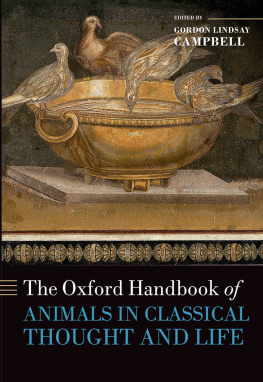Title Page
Animal Husbandry and Allied Technologies in Ancient India
From Prehistorical to Early Historical Times
P.P. Joglekar
Pankaj Goyal
Senior Editor
O.C. Handa

Copyright
Indus-Infinity Foundation 2020
Published in 2020 by
Infinity Foundation India,
3/56A, Dr. Ranga Road,
Alwarpet,
Chennai-600018
All rights reserved under Indian Copyright Conventions. By payment of the required fees, you have been granted the nonexclusive, nontransferable right to access and read the text of this e-book on-screen. No part of this text may be reproduced, transmitted, downloaded, decompiled, reverse-engineered, or stored in or introduced into any information storage and retrieval system, in anyform or by any means, whether electronic or mechanical, now known or hereafter invented, without the express written permission of Infinity Foundation India e-books.
e-Book
203v1.0.0
Date: 09-09-2020
ISBN: 9788194689225
Created by: Sriranga Digital Software Technologies Private Limited
srirangadigital.com

Dedicated to our beloved teacher Late Dr. P. K. Thomas (1947-2014),
who was like a lighthouse to us in our professional careers
Foreword to the Series
INDIA HAS HAD A LONG HISTORY OF CIVILISATION GOING BACK SEVERAL thousand years. In the global mind this civilisation is largely associated with spiritualism, philosophy and religiosity. There is also appreciation of great traditions that have continued: of performing arts in dance and music; of magnificent works in architecture, sculpture, painting; and of artisanal output of quality relating to the crafts. Over the last couple of centuries the image has been significantly one of poverty: surprising when John Milton in Paradise Lost had referred to the wealth of Ormuz and of Ind. For many, it is a land of magicians and snake-charmers; of wild animals, like tigers and elephants; of mendicants, and mystics. This image is changing today with India moving powerfully into the knowledge economy and becoming a power to reckon with. What is not known and appreciated is the extent to which a whole knowledge system, and particularly scientific thought, has been inextricably linked to the development of this ancient and continuing civilisation.
There are many reasons for this. An important one is that there has been no major work on the history of science and technology in India. This is not to say that no work has been done in this field; there is a great deal available relating to specific areas, and involving specialised discussion, more so concerning technology. But there is nothing covering science and technology as a whole, dealing with the many diverse areas that it covered, and particularly its very different conceptual foundations, as also the extent to which it has underpinned the development of Indian society and civilisation. Because of this, in authoritative encyclopaedias, (such as Encyclopaedia Britannica), Indian science and technology is dealt with in a few hundred words. This must be contrasted with the situation in respect of China, following the great work of Dr. Joseph Needham, who produced thirty odd volumes on the history of science and technology of that country. This made a monumental impact in the academic repositioning of China as a scientific, rational and progressive civilisation. There is need for a similar effort with regard to Indian science and technology.
A further reason for the rather poor appreciation of the history of Indian science is that, in the public eye, the development of science and technology is manifested through its innumerable technological artefacts that affect daily lives in society, and great scientific discoveries, both of which rapidly followed the developments that took place around a few hundred years ago in Europe with the birth of the modern, ongoing Scientific and Industrial Revolutions. As a result, the image of western science is so overwhelming that it swamps all earlier history.
In the West, there is major reference to the Greek origins of western philosophy and scientific thought. There was a strong coupling of Arab and Greek science, particularly as manifested in the historical Library of Alexandria. It must be remembered that India was an open country, and had significant interactions with the Arab world. Also, western scholars of the pre-Christian era had information on India through reports of Greek origin. It is, thus, that the Zero and the Decimal place value system became international and got referred to as the Arabic numerals; but those had their origins in India. Indeed Zero had a deep philosophical meaning, that was characteristically Indian, denoting nothing or emptiness.
There are many who, without a deep appreciation of the character of indigenously developed knowledge structures in India, often propagate the idea that science (which was so intimately interwoven with those knowledge structures) came to India from the outside through Islamic and Western conquests. The fact is that India absorbed all that came in from the outside (whether by invasion or otherwise) and gave freely of itself to the East and to the West; it was an open society.
The following reasoning may provide an indication why it has been difficult to compile a meaningful and reasonably comprehensive history of science and technology in India.
A great deal of knowledge transmittal in India has been through the oral tradition, having been conveyed through chants, hymns, poems and the like; this has been true even in mathematics. Those do not remain in the written record, and much of it has probably been lost with the cataclysmic changes in Indian society.
What has been written has invariably been on palm leaf and such other materials, followed by paper recordings; this is particularly the case for the earlier period in history prior to the advent of printing. A great deal of the source material on which writing has taken place, would have been subject to ravages of weather and insects, since India is located in the tropics characterised by high temperatures and humidity. After printed books came into existence, which ensured the availability of many copies of a text, India has not had a great history in science and technology, except in the last century.
Even when written, this was in the language then prevailing, namely, Sanskrit, particularly of the archaic variety and other related languages; there was also the problem of scripts. In recent years, one finds that those who know those scripts and languages, particularly their older forms, have little knowledge or interest in matters that are scientific. Their interests largely lie in areas of literature, philosophy, religion and the like. In contrast, those who know science, and could contribute to a meaningful analysis of recorded history, have scant knowledge of the language and the scripts of the past and often little interest.
Finally, what was transmitted, even on matters that were scientific, was mixed up with a great deal of philosophy, religion and mysticism; often practitioners of science of those days were philosophers or those high up in the socio-religious hierarchy. Knowledge in ancient India was much less compartmentalised; it was characterised by a holistic approach. To extract that which would be regarded as science, from this totality, is not an easy task. For all these reasons, the overall effort relating to writing of the history of science and technology in India has been a limited and scattered effort.











